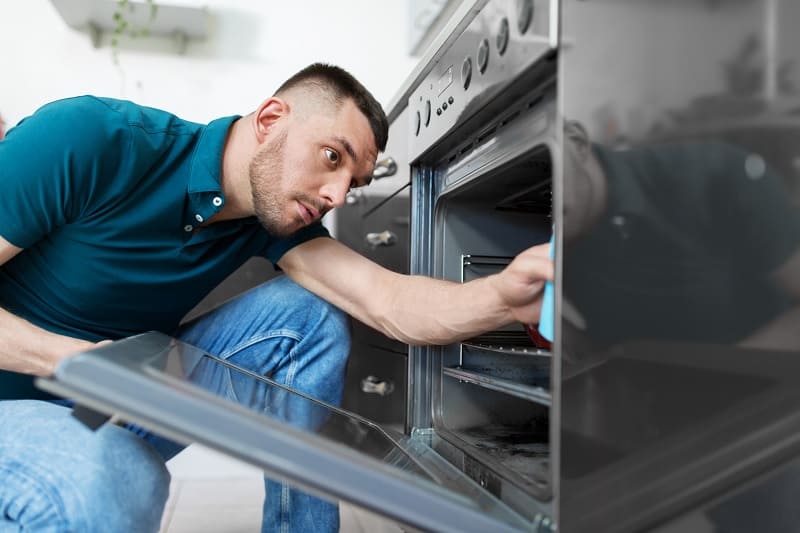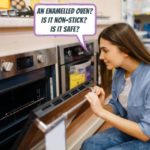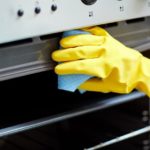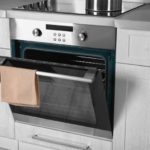If you’re looking for a new oven, then I’m sure that during your research you’ve come across the hotly debated topic of enamel, catalytic and pyrolytic linings and which is best.
Well, we’re here to throw our hat into this increasingly confusing ring. We know our readers love to keep things simple and enjoyable in the kitchen, and having a liner that makes cleaning easy is a sure-fire way of keeping kitchen cleaning easy.
However, which liner is going to help you keep your oven cleanest for longer? Well, let’s look at each oven liner first and then delve deep into the dark world of this cooker debate, shall we?
Enamel
Enamel liners in ovens are the most common of the three. These are in loads of ovens now. Essentially, an enamel liner creates a very smooth surface, so grease and dirt have a harder time sticking to it.
Although food can still build up on enamel liners, regular cleaning will mean that built-up food is kept to a minimum. Enamel liners in ovens are now very common. This means they are the cheapest of all three liners and they can help prevent your oven from becoming dirty really quickly.
However, unless you maintain the enamel liner and a good cleaning schedule, food build-up is still inevitable.
Catalytic
Catalytic oven liners are an excellent way of reducing the amount of cleaning you have to do. These liners actually absorb food and grease and break them down. All of this broken-down food and grease is then simply burnt away during cooking. Catalytic liners are safe and non-toxic.
Most oven companies state that if you don’t run your oven very regularly over 200ºC, then you should heat your oven at 220ºC for thirty minutes or so every month, to ensure the food and grease are burnt away.
A great thing about catalytic oven lining is that since it’s becoming increasingly popular, you no longer need a huge budget to enjoy this type of self-cleaning oven. If you really hate cleaning your oven, it is probably worth the extra cost!
Keep in mind though, depending on the model of oven, every surface of the oven cavity might not be fitted with catalytic liners. Those surfaces that aren’t will likely have an enamel liner, or something similar and so you will still have to clean those areas of the oven regularly.

Pyrolytic
The easiest way of keeping an oven clean is pyrolytic cleaning. Now, pyrolytic cleaning is actually a method of cleaning your oven, rather than a liner like the other two in this hot debate.
Ovens that include pyrolytic cleaning have a special program on them. When you turn this program on, the oven runs to temperatures of over 400ºC. Once the pyrolytic cleaning program has finished, typically this program takes about two hours, the food is turned to ash, and you can simply brush it away.
Most pyrolytic ovens have an automatic door lock too, so once the program is started, no little hands can open the oven until it has cooled off to a safer temperature.
As I said earlier, pyrolytic cleaning can often take about two hours, which is longer than catalytic programs, for example. However, just set the oven to complete the pyrolytic cleaning when you don’t need the oven for a few hours and then clean up the ash when you get a chance.
Of course, as pyrolytic cleaning is a new, handy-dandy technology (at least, compared to other liners), your choice of ovens is reduced with this tech, and you’ll need a bit of bigger budget.

Which Is Best for Cleaning?
While pyrolytic ovens are the easiest to clean, which is best for you all comes down to which makes your life easier. The type of cooker that you buy depends on your needs, your budget, and how much time you have to clean it.
If you don’t have the time to clean your oven once a month and you have the budget for it, then absolutely, get an oven with pyrolytic cleaning included. It’s a fantastic way to keep your oven clean.
However, if a pyrolytic oven isn’t in your budget, I would go for a catalytic oven. These require very minimal cleaning and will make your life a lot easier.
And, if you don’t mind giving your oven a thorough cleaning once a month or so, get an enamel lined oven. These are still fantastic ovens, and you’ll save a bit of money too.
Conclusion
While we may not have totally sorted the debate about which is better, we hope we have helped you choose your next oven. The tricky thing is that these different oven liners are all fantastic and do the job they were meant to do brilliantly.
The easiest way to choose between these great oven liners is to look at the pros and cons above, see which oven suits your lifestyle and your budget and then get the best deal you can on an oven with that liner.
If you’re looking for a new oven, check out these recommended built-under double ovens.

Chef’s Pick is your guide to the best kitchen equipment and appliances in the UK.
We help you understand the confusing world of cookers, ovens and cookware so you can get the most out of your kitchen.







